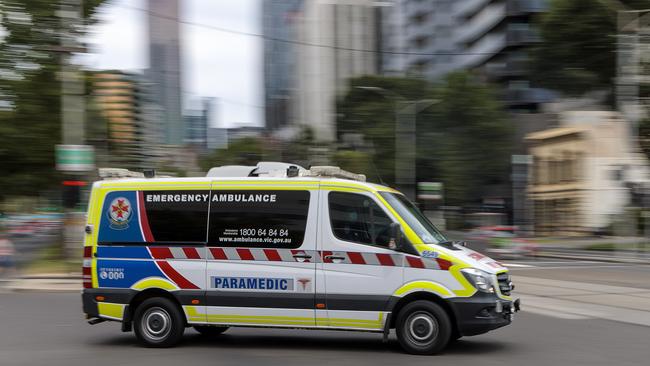Scathing report finds 33 Victorians died waiting too long for ambulances
The IGEM found Victoria’s classification of emergencies has ‘simply served to confuse rather than create benefit to agencies and departments’.

At least 33 Victorians died after waiting too long for ambulances between December 2020 and May 2022, the state’s Inspector-General for Emergency Management has found.
IGEM Tony Pearce identified 40 potential “adverse events”– involving seriously ill and injured patients during the period – which he said were associated with “call answer delays, agency command and control decisions, and/or ambulance resourcing issues.”
“Tragically, 33 of these patients did not survive their emergencies,” Mr Pearce found.
“This does not necessarily mean that call answer delay was a contributing factor because in some cases no amount of rapid intervention would have saved the patient.
“What it does mean is that due to these call answer delays, the community waited longer to receive important first-aid advice, and paramedics had less time to apply advanced treatment in time to make a difference to the patient’s outcome.”
Despite having received Mr Pearce’s more than three weeks ago, and a promise from Attorney-General Jaclyn Symes that it would be released before the end of August, the Andrews government has chosen to release it on a Saturday morning in September, amid AFL finals.
The 156-page review of Victoria’s emergency ambulance call answer performance has been released alongside a separate 180-page IGEM report into the state’s preparedness for major public health emergencies, including pandemics.
It follows the handing down in May of Former police chief Graham Ashton’s damning review of the Emergency Services Telecommunications Authority, which the government released two days ahead of the federal election.
Key among Mr Pearce’s findings in his pandemic preparedness report is that Victoria’s classification of emergencies into police, fire and ambulance is a “peculiarly Victorian arrangement” which has “simply served to confuse rather than create benefit to agencies and departments”.
The damning reports come less than three months out from the November state election, and after a week which saw Premier Daniel Andrews seek to gain political advantage from a joint press conference held with Dominic Perrottet at which the NSW Premier deal a blow to his Victorian Liberal counterparts by saying the state’s ongoing health crisis is “not unique”.
In his ambulance call answer performance review, Mr Pearce identified “significant declines” in ESTA’s emergency ambulance call answer times, commencing in December 2020, “with ambulance call activity increasing beyond historical highs, and emergency calls queuing for completely unacceptable lengths of time – 10 minutes, 15 minutes, and longer.”
Cases referred to Coroner
Mr Pearce cited legislation introduced by the Napthine government in 2013 in explaining that he was limited in the information he was able to provide in terms of cases studies illustrating the potential adverse events, as he was not legally permitted to identify those affected.
“I do not make any findings about whether the associated performance issues may have contributed to the passing of these patients, or whether faster intervention may have prevented deaths,” he found.
“These important questions are for the jurisdiction of the Coroners Court of Victoria, with whom I have liaised closely and will be providing further information not contained in this report.
“I therefore apologise to the families and friends of those 33 people, if their expectations of this report are not met concerning the circumstances of their loved ones’ emergencies.
“I assure you that I will continue to consult with the State Coroner to ensure they are in possession of all relevant information so that they may acquit their critical function to investigate and make findings about these events, and to obtain for you the answers you deserve.”
Mr Pearce found the “key reason” for the delays in calls being answered was “resourcing” at ESTA.
“Since December 2020 – and more specifically since October 2021, when its call answer speed performance dropped below 70 per cent of Triple Zero calls answered in five seconds, ESTA simply did not have sufficient ambulance call-takers to meet incredible demand,” he found.
“ESTA missed opportunities to recruit and deploy additional emergency ambulance call-takers during the pandemic, particularly in 2020.
“This was for several reasons, one of which is related to the existing funding model to which ESTA is subject.
“Another reason for shortfalls in call-takers related to the need to furlough employees affected by Covid-19 itself; a situation that affected all emergency services organisations and the broader health sector at various times during the pandemic.”
Mr Pearce also found the pandemic contributed to increased demand for ambulances.
“For much of the duration of the pandemic, and especially when the population was unvaccinated, we have been told of its contagious and deadly characteristics. Little wonder, perhaps, that the first response of many facing a loved one displaying symptoms was to see this as an emergency and to ring Triple Zero for an ambulance. Sometimes this was warranted, at other times, not,” he wrote.
“This was not assisted by a lack of community education and information about when to ring for an ambulance in the early stages of the pandemic, and further complicated by the difficulties many Victorians experienced in seeking healthcare during lockdowns.
“The significant system impacts that flow from unwarranted calls to the emergency services highlight the need for much closer cooperation between agencies around public messaging and much better communication with the Victorian community about when it is appropriate to ring Triple Zero.”
Mr Pearce found emergency ambulance call answer performance had improved since May, with fewer Triple 0 calls left waiting to be taken, less extreme wait times. ESTA reported emergency ambulance call answer performance of 86.2 per cent in June 2022.
“Although still below benchmark, this is a significant improvement on ESTA’s lowest monthly
performance of 39 per cent of such calls being answered at or within five seconds in January 2022,” he found.
“This improvement has no doubt been due to some urgent interventions by government and the committed efforts of ESTA.”
Mr Pearce made 42 findings and eight recommendations, all of which the Andrews government has undertaken to implement.
ESTA funding model
Mr Pearce found ESTA’s existing fee and funding model was “insufficient”, and did “not provide adequate funding to cover ESTA’s costs due to demand growth and increases in wages under industrial agreements.”
He further found the Andrews government had been aware of ESTA’s “precarious financial position” as early as 2015, via the findings of an Auditor-General’s report.
“Since 2014-15, ESTA has sought, and government has provided, annual supplementary funding via the Victorian State Budget for its structural deficit,” Mr Pearce found.
“The ad hoc nature of the year-to-year supplementary funding arrangements limits ESTA’s ability to recruit to meet demand. It also limits ESTA’s ability to plan beyond 12 months or implement longer-term investments to improve the service during business-as-usual and surge events.
“IGEM notes that work is currently ongoing between the Department of Justice and Community Safety, the Department of Treasury and Finance, Emergency Management Victoria and ESTA to provide government with options on a sustainable funding model.
“However, such work began more than 10 years ago and is yet to be completed. It is critical that an agreed and sustainable funding model is put in place for ESTA as soon as possible.
“The agreed funding model should not only consider and reflect the increasing demand due to Victoria’s changing demographics, but also consider the increasing frequency and severity of emergency events and the need for a surge workforce.”
‘A peculiarly Victorian arrangement’
In March, The Australian revealed funding for an extra 43 Victorian ambulance call-takers was initially budgeted by the Andrews government only as a “contingency”, delaying the recruitment of the crucial staff by up to six months.
ESTA insiders told this newspaper the 43 staff would have been trained and working during the period what was then believed to be 12 deaths occurred, had the money for their employment been prioritised.
The same insiders also highlighted challenges associated with managing relationships with the four unions that cover emergency call-takers in Victoria: United Firefighters Union, Communications Workers Union, United Workers Union and Victorian Ambulance Union.
One insider said the “rigidity” of rostering requirements under the workers’ enterprise bargaining agreements made it almost impossible for ESTA to have the flexibility needed to fill shifts during times of high demand; another said trying to get the four unions to agree to anything was like “trying to keep mice under a blanket”.
Mr Pearce went to the classification of emergencies as police, fire or ambulance in his separate review of Victoria’s preparedness for major public health emergencies including pandemics, finding that “while the control and support arrangements which have been in place for different emergencies for many years continue to serve us well, it is difficult to escape the conclusion that the division of emergencies into classes – a peculiarly Victorian arrangement – has simply served to confuse rather than create benefit to agencies and departments.”
“Further, there is no evidence to show how classification has improved agency accountability or improved community safety outcomes, both of which being objectives that our emergency management arrangements and governance structures should aim to achieve,” he found.

Government responds
Victorian Attorney-General and Minister for Emergency Services Jaclyn Symes said the government accepted the findings and supported all the recommendations in both reports.
“Work on many of these recommendations is already well underway to immediately improve ESTA’s call-taking performance, following former Victoria Police chief commissioner Graham Ashton’s review of the service,” Ms Symes said.
“ESTA has already brought on more than 150 new call-takers and dispatchers, provided more training, more flexible rosters, more mental health support for staff and created a surge pool of call-takers for periods of high demand.
“The pandemic saw emergency ambulance call volumes increase from a pre-pandemic average of around 2200 calls per day to nearly 4000 at the peak of the Omicron surge. Our Ambulance Victoria paramedics responded to more than 93,000 Code 1 callouts in the January quarter, breaking the record set in the previous quarter.
“Since these reviews began, the government has made significant investments to strengthen Victoria’s emergency call-taking service – with more than $333 million to meet demand, bring on more than 400 extra staff, build better support and surge capability for busy times and provide more support to frontline workers.
“This investment has seen vast improvements in call-taking performance since January 2022 – the IGEM has advised the Government that August 2022 call-taking performance has seen 92.8 per cent of all calls answered within five seconds, exceeding the benchmark for the first time since October 2021.”
Ms Symes said she offered her “deepest sympathies to those who have lost their loved ones during the pandemic”.






To join the conversation, please log in. Don't have an account? Register
Join the conversation, you are commenting as Logout